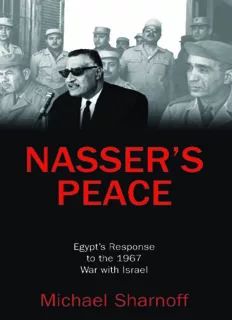
Nasser’s Peace: Egypt’s Response to the 1967 War with Israel PDF
Preview Nasser’s Peace: Egypt’s Response to the 1967 War with Israel
NASSER'S PEACE Nassers Peace.indb i 08/02/17 11:18 AM NASSER'S PEACE Egypt's Response to the 1967 l War with Israel Michael Sharnoff • Transaction Publishers Nassers Peace (NP)_FM.indd iii 15/02/17 3:35 PM Copyright © 2017 by Transaction Publishers Transaction Publishers is an imprint of the Taylor & Francis Group, an informa business All rights reserved under International and Pan-American Copyright Conventions. No part of this book may be reproduced or transmitted in any form or by any means, electronic or mechanical, including photocopy, recording, or any information storage and retrieval system, without prior permission in writing from the publisher. All inquiries should be addressed to Taylor & Francis, 711 Th ird Avenue, New York, NY 10017, USA. Th is book is printed on acid-free paper that meets the American National Standard for Permanence of Paper for Printed Library Materials. Library of Congress Catalog Number: 2016048822 ISBN: 978-1-4128-6515-9 Printed in the United States of America Library of Congress Cataloging-in-Publication Data A catalog record for this book has been requested Nassers Peace (NP)_FM.indd iv 09/02/17 4:44 PM Contents Acknowledgments ix A Note on Transliteration xi Abbreviations xiii Introduction 1 1. Nasser’s Pre-1967 Peace Perception 9 The Paradox of Nasser’s Pan-Arab Ideology and Actions 10 The Gaza Dilemma 11 The Bandung Conference 12 The 1956 Suez War 12 Nasser’s Palestine Policy during the 1960s 15 The Road to War 19 2. Nasser’s 1967 War Defeat 27 Egyptian Attacks on Westerners and Jews 28 Nasser Resigns and the Collusion Myth 29 Nasser’s Toleration of the “Big Lie” 32 Nasser Resumes as President 35 The Chinese–Egyptian–Soviet Triangle 37 Israel’s Postwar Position 40 3. Nasser’s Responses to United Nations’ Proposals 49 Nasser Reshuffles His Cabinet 53 The Soviet Proposal 53 The American Proposal 55 The Albanian Proposal 57 Israel Annexes the Old City 58 Nassers Peace.indb v 08/02/17 11:18 AM The Nonaligned Proposal 59 The Latin American Proposal 61 The Pakistani Proposal 62 UN Indecision 63 4. Clandestine Meetings at the United Nations 73 The Salah Nasir Note 75 The Sincerity of Negotiations 76 Gromyko’s First Series of Talks with Fawzi 80 Nasser–Podgorny Talks 82 Johnson–Kosygin Meeting 87 Private Egyptian Talks 88 Gromyko’s Second Series of Talks with Fawzi 90 5. Arab Summits and Clandestine Meetings 95 The Cairo “Little Summit” 100 A Potential Diplomatic Breakthrough? 102 Nasser–Malik Talks 103 Boumedienne and Aref Travel to Moscow 105 The Revised American-Soviet Draft Resolution 107 Reactions to Nasser’s Alleged Diplomatic Breakthrough 108 6. Nasser’s Palestine Policy, Khartoum, and Tito’s Proposal 113 The Arab League Khartoum Summit 115 Khartoum Results: A Victory for Conservatives or Radicals? 119 Tito’s Peace Proposal 121 7. Nasser’s British Strategy 131 Nasser’s Meeting with Sir Dingle Foot 134 The Nasser–Beeley Meeting 138 Nasser’s British Policy: Sincere or a Ploy? 142 8. United Nations Deliberations and Private Party Negotiations 147 Ashraf Ghorbal’s Meeting with Richard Parker 152 Nassers Peace.indb vi 08/02/17 11:18 AM Nasser’s Meeting with Siddiqui 153 Mahmoud Riad’s Meeting with Robert Anderson 156 Vasili Kuznetsov’s Meeting with Riad 157 Vladimir Vinogradov’s Talks with Nasser 157 9. Nasser’s Meeting with Robert Anderson 163 Egyptian and Lebanese Accounts of the Meeting 164 Anderson’s Account of the First Meeting with Nasser 165 Anderson’s Account of the Second Meeting with Nasser 171 10. Nasser and UN Resolution 242 179 Mahmoud Riad’s November 9 Address to the Security Council 183 Muhammad Heikal’s Commentary 184 The British and Soviet Draft Resolutions 186 UN Resolution 242 187 Nasser’s Speech to the National Assembly 189 The Proposed Rabat Summit and the Jarring Mission 193 Toward a War of Attrition 195 Conclusion 203 Bibliography 213 Index 229 Nassers Peace.indb vii 08/02/17 11:18 AM Acknowledgments I am greatly indebted to the following individuals for their advice and assistance: Efraim Karsh, Rory Miller, Michael Kerr, Jehan Sadat, Linda L. Woolridge, Doron Avi-Ad, Israel Gershoni, Miladin Milošević, Bruno Derrick, Ian Strawbridge, Lynsey Robertson, Mike Walker, Youssef Ziedan, Reem Saad, Khaled Fahmy, Judith Vera, Luisa Parrado, Fred Burchsted, Bradley L. Schaff ner, Mark Kramer, Harold M. Leich, Joel Gordon, John Buchtel, Scott S. Taylor, Lynsey Robertson, Ella Molenaar, and Kamel Labidi. I am especially grateful to the staff at the Maughan Library, the Brit- ish Library of Political and Economic Science, the School of Oriental and African Studies Library, the British Library, Th e National Archives, the Library of Congress in Washington, D.C., and the National Archives at College Park, Maryland. Finally, I wish to thank my family and friends for all their love and support. Any errors in the fi nal manuscript, needless to say, are mine alone. ix Nassers Peace.indb ix 08/02/17 11:18 AM
Description: